Your Free Handout
Using Gibbs’ Reflective Cycle
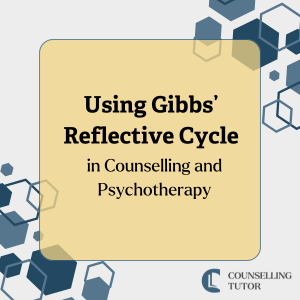
Reflection is a vital part of a counsellor’s professional development. It enables deeper self-awareness, improved decision-making, and enhanced client outcomes. One of the most widely used frameworks for structured reflection is Gibbs’ Reflective Cycle (1988).
This six-stage model provides a clear and systematic approach to examining experiences, identifying learning points, and planning for future practice.
For counsellors and psychotherapists, Gibbs’ Reflective Cycle can facilitate personal and professional growth by encouraging critical thinking, emotional awareness, and evidence-based practice. This article explores how to use each stage of the cycle effectively in counselling and psychotherapy.
Using Gibbs’ Reflective Cycle
By the end of this article, you will:
The first step in reflection is to describe the situation or event clearly.
This includes:
Keeping the description concise and focused is essential, as it provides the foundation for deeper reflection. Avoid including unnecessary details that do not contribute to your analysis.
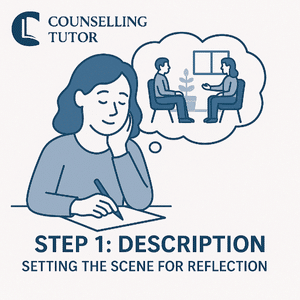
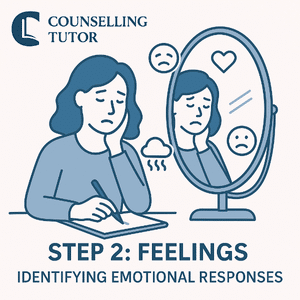
This stage allows you to explore your emotional reactions to the event.
Consider:
As you reflect, your feelings will likely impact the event and your perspective, so this stage is crucial to the reflective process.
Emotions play a crucial role in counselling, shaping the therapeutic relationship and influencing decision-making. Acknowledging and understanding your feelings can improve self-awareness and professional boundaries.
At this stage, critically assess the effectiveness of your approach:
You will likely draw on the literature and appropriate references to support your evaluation. This will help you provide a more objective perspective on what worked well and what challenges arose.
Evaluation helps you recognise strengths while identifying areas for development. It also encourages an honest assessment of your practice and highlights where adjustments may be needed.

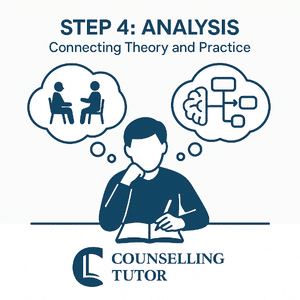
The Analysis stage is where deeper reflection occurs.
This involves examining:
At this stage, personal experience and theoretical perspectives meet. Analysis is a crucial element of the reflective process, helping you understand whether your experience aligns with or differs from existing research and theory.
For example, if a client exhibits resistance, you might explore this through defence mechanisms (Freud) or the stages of change model (Prochaska & DiClemente). Integrating theory into your reflections allows you to ground your insights in evidence-based practice.
This stage summarises key takeaways from the experience.
Ask yourself:
At this stage, you will also discuss the areas you feel went well, whether you would act similarly in future, or if there is anything you might do to improve upon your successes.
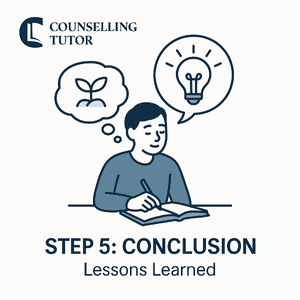
A well-structured conclusion ensures that reflection leads to meaningful learning and informs future practice.

The final stage involves planning how to apply learning to future practice. All positive actions you are considering due to your reflections should be outlined at this stage. This might include implementing strategies to avoid a similar outcome, focusing on a particular learning area, or consulting with a tutor or supervisor.
Consider:
An action plan ensures that reflection leads to concrete improvements, making it a valuable tool for continuous professional development.
Using Gibbs’ Reflective Cycle
Gibbs’ Reflective Cycle is a six-stage model that guides counsellors through structured reflection, helping them analyse sessions, understand emotional responses, and integrate theory with practice to improve future client work.
Exploring emotional responses helps counsellors understand how their feelings affect interventions and the therapeutic relationship, enhancing self-awareness and professional boundaries.
The action plan outlines concrete steps for future improvement, such as applying new strategies, seeking supervision, or building emotional resilience through self-care.
Gibbs’ Reflective Cycle offers a structured and practical approach to reflection. It helps counsellors and psychotherapists develop self-awareness, bridge theory with practice, and refine their professional skills. By systematically examining experiences, practitioners can gain deeper insights into their interactions, recognise areas for growth, and make informed adjustments to enhance their effectiveness.
Incorporating this reflective model into supervision, journaling, or professional discussions encourages continuous learning and professional development. Regular reflection builds competence and confidence and supports ethical, client-centred practice – ensuring that practitioners continue to evolve and deliver the best possible outcomes for those they support.
Gibbs, G. (1988). Learning by doing: a guide to teaching and learning methods. London: FEU.
Counselling Tutor provides trusted resources for counselling students and qualified practitioners. Our expert-led articles, study guides, and CPD resources are designed to support your growth, confidence, and professional development.
👉 Meet the team behind Counselling Tutor
Notice any broken link or issues with this resource? Kindly let us know by email
Email us